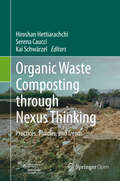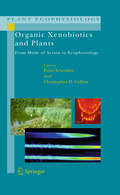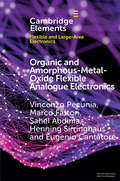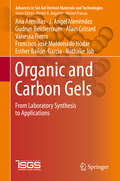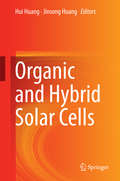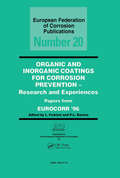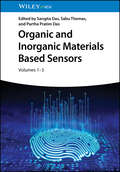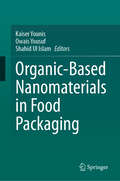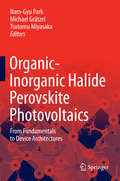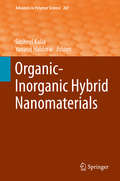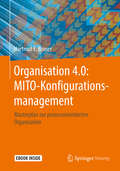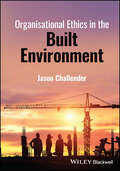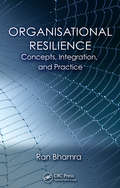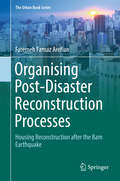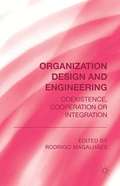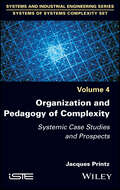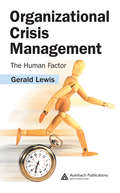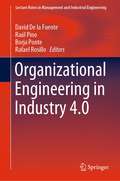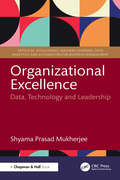- Table View
- List View
Organic Waste Composting through Nexus Thinking: Practices, Policies, and Trends
by Hiroshan Hettiarachchi Kai Schwärzel Serena CaucciOrganic waste composting is another excellent example to demonstrate the power and the benefits of nexus thinking. Even though organic waste composting itself is not a new topic, those who want to start a new project or align an ongoing project with nexus thinking, find it difficult to gather the necessary information. With nine case studies from four continents, this book aims to fill above gap in literature. While current literature on composting is often found to be limited to either soil/agriculture sector or waste management sector, this book presents a combined point of view. This open access book starts with an introductory chapter that describes the need to bring the waste management aspects and soil nutrient management aspects of compost production into one integrated theme. The relevance of nexus thinking and the Sustainable Development Goals (SDGs) are also presented in this introduction. The first three chapters after the introduction covers composting from the solid waste management and its policy aspects, taking examples from three developing countries. The next three examples are mostly about the benefits composting can provide to the soil and agriculture. These examples are also from three developing countries, but with a mixture of urban as well as rural settings. Last three chapters present more insight into the latest developments taking examples from Europe, as well as new methods adapted from the traditional styles from Africa.
Organic Xenobiotics and Plants
by Christopher D. Collins Peter SchröderNatural and agro-ecosystems are frequently exposed to natural or synthetic substances, which, while they have no direct nutritional value or significance in metabolism, may negatively affect plant functioning. These, xenobiotics, may originate from both natural (fires, volcano eruptions, soil or rock erosion, biodegradation) and anthropogenic (air and soil pollution, herbicides) sources. And, while affected plants have only a limited number of possibilities for avoiding accumulation of these compounds, they do exhibit several enzymatic reactions for detoxification including oxidation, reduction, hydrolysis and conjugation reactions. In agro-ecosystems in particular these mechanisms have great significance in relation to herbicide detoxification and tolerance. In this volume an international group of experts present an overview of the nature and distribution of organic xenobiotics, including their uptake, effects on plant functioning and detoxification mechanisms. The particular significance of glutathione S-transferases in bio-indication and bio-monitoring, and in the detoxification of volatile organic air pollutants and herbicides is evaluated, and their potential significance in phytoremediation and bioaccumulation will be discussed. This volume will be of interest to a wide audience, from graduate students to senior researchers in a wide range of disciplines including plant ecology, plant biochemistry, agriculture and environmental management. It will also be of practical interest to environmentalists, policy makers and resource managers.
Organic and Amorphous-Metal-Oxide Flexible Analogue Electronics (Elements of Flexible and Large-Area Electronics)
by Eugenio Cantatore Sahel Abdinia Vincenzo Pecunia Marco Fattori Henning SirringhausRecent years have witnessed significant research efforts in flexible organic and amorphous-metal-oxide analogue electronics, in view of its formidable potential for applications such as smart sensor systems. This Element provides a comprehensive overview of this growing research area. After discussing the properties of organic and amorphous-metal-oxide technologies relevant to analogue circuits, this Element focuses on their application to two key circuit blocks: amplifiers and analogue-to-digital converters. The Element thus provides a fresh look at the evolution and immediate opportunities of the field, and identifies the remaining challenges for these technologies to become the platform of choice for flexible analogue electronics.
Organic and Carbon Gels: From Laboratory Synthesis to Applications (Advances in Sol-Gel Derived Materials and Technologies)
by Ana Arenillas J. Angel Menéndez Gudrun Reichenauer Alain Celzard Vanessa Fierro Francisco José Maldonado Hodar Esther Bailόn-Garcia Nathalie JobThis expert volume provides specialized coverage of the current state of the art in carbon gels. Carbon gels represent a promising class of materials with high added value applications and many assets, like the ability to accurately tailor their structure, porosity, and surface composition and easily dope them with numerous species. The ability to obtain them in custom shapes, such as powder, beads, monoliths, or impregnated scaffolds opens the way towards numerous applications, including catalysis, adsorption, and electrochemical energy storage, among others. Nevertheless, it remains a crucial question as to which design synthesis and manufacturing processes are viable from an economic and environmental point of view. The book represents the perspectives of renowned specialists in the field, specially invited to conduct a one-day workshop devoted to carbon gels as part of the 19th International Sol-Gel Conference, SOL-GEL 2017, held on September 3rd, 2017 in Liège, Belgium.Addressing properties and synthesis through applications and industry outlook, this book represents essential reading for advanced graduate students through practicing researchers interested in these exciting materials.
Organic and Hybrid Solar Cells
by Hui Huang Jinsong HuangThis book delivers a comprehensive evaluation of organic and hybrid solar cells and identifies their fundamental principles and numerous applications. Great attention is given to the charge transport mechanism, donor and acceptor materials, interfacial materials, alternative electrodes, device engineering and physics, and device stability. The authors provide an industrial perspective on the future of photovoltaic technologies.
Organic and Inorganic Coatings for Corrosion Prevention: Research and Experience, Papers from EUROCORR '96
by L. FedrizziOrganic and Inorganic Coatings for Corrosion Prevention - Research and Experiences is a collection of Papers from EUROCORR '96 and published for the European Federation of Corrosion by The Institute of Materials. In the session on Coatings the following topics were discussed: • Life-time prediction of organic coatings; • Environmentally friendly coatings; • Testing; and • Surface preparation techniques. This book contains a selection of the scientific work presented in the Conference with the aim of focusing on the research developments in the frame of corrosion protection coatings for industrial use. The book is in four sections describing, respectively, organic coatings, zinc coatings, other metallic coatings and ceramic coatings.
Organic and Inorganic Light Emitting Diodes: Reliability Issues and Performance Enhancement
by Wladek Grabinski T. D Subash J AjayanThis book covers a comprehensive range of topics on the physical mechanisms of LEDs (light emitting diodes), scattering effects, challenges in fabrication and efficient enhancement techniques in organic and inorganic LEDs. It deals with various reliability issues in organic/inorganic LEDs like trapping and scattering effects, packaging failures, efficiency droops, irradiation effects, thermal degradation mechanisms, and thermal degradation processes. Features: Provides insights into the improvement of performance and reliability of LEDs Highlights the optical power improvement mechanisms in LEDs Covers the challenges in fabrication and packaging of LEDs Discusses pertinent failures and degradation mechanisms Includes droop minimization techniques This book is aimed at researchers and graduate students in LEDs, illumination engineering, optoelectronics, and polymer/organic materials.
Organic and Inorganic Materials Based Sensors, 3 Volumes
by Sabu Thomas Partha Pratim Das Sangita DasOrganic and Inorganic Materials Based Sensors A three-volume comprehensive overview of the development and applications of various novel potent molecular sensor frameworks In Organic and Inorganic Materials Based Sensors (3 Volume Set), a team of distinguished researchers delivers an interdisciplinary presentation of the engineering of high-performance biopolymer-based bio-nanocomposites, as well as strategies for the use of various molecules in the detection of environmentally important guest analytes. This three-volume book explores the most relevant technological developments in nanomaterials sensors and offers a broad and comprehensive overview of cutting-edge research on advanced materials in the fast-moving sensors industry. The authors explain the science behind nanomaterials for environmental remediation as well as the components and ingredients of the relevant materials. Readers will also find: Thorough introductions to sensory devices, polymer-based nano-biomaterials, and opto-electrochemical devices Comprehensive explorations of metal–organic frameworks, organic sensors, and organic–inorganic composite semiconductor sensors Practical discussions of vapochromic and vapoluminescent sensors Fulsome treatments of sensor ecosystems for health self-monitoring, including discussions of diabetes management Perfect for materials scientists, mechanical engineers, and analytical chemists, Organic and Inorganic Materials Based Sensors will also benefit inorganic and organic chemists, robotics engineers, and professionals working in the sensor industry.
Organic and Molecular Electronics: From Principles to Practice
by Michael C. PettyAn introduction to the interdisciplinary subject of molecular electronics, revised and updated The revised second edition of Organic and Molecular Electronics offers a guide to the fabrication and application of a wide range of electronic devices based around organic materials and low-cost technologies. Since the publication of the first edition, organic electronics has greatly progressed, as evidenced by the myriad companies that have been established to explore the new possibilities. The text contains an introduction into the physics and chemistry of organic materials, and includes a discussion of the means to process the materials into a form (in most cases, a thin film) where they can be exploited in electronic and optoelectronic devices. The text covers the areas of application and potential application that range from chemical and biochemical sensors to plastic light emitting displays. The updated second edition reflects the recent progress in both organic and molecular electronics and: Offers an accessible resource for a wide range of readers Contains a comprehensive text that covers topics including electrical conductivity, optical phenomena, electroactive organic compounds, tools for molecular electronics and much more Includes illustrative examples based on the most recent research Presents problems at the end of each chapter to help reinforce key points Written mainly for engineering students, Organic and Molecular Electronics: From Principles to Practice provides an updated introduction to the interdisciplinary subjects of organic electronics and molecular electronics with detailed examples of applications.
Organic-Based Nanomaterials in Food Packaging
by Shahid Ul Islam Kaiser Younis Owais YousufThe use of nanomaterials in food packaging is a rapidly advancing area with massive potential for increasing shelf life and improving the safety of food products. Up to this point there has not been a suitable reference work covering the basic modules of organic-based nanomaterials in food packaging. This work documents organic nanomaterials and their synthesis; Characterization, composition and structure of organic nanomaterials; Mechanical properties of organic nanomaterials; Cellulose, Starch, Chitosan, protein and conjugated organic nanomaterials for food packaging plus nano emulsions for edible coating and the overall safety and regulatory aspects of organic nanomaterials. Organic-Based Nanomaterials in Food Packaging is designed to serve researchers, students in food science and technology and food processing, and food industry professionals as well. With chapters covering the synthesis of organic nanomaterials, characterization, composition and structure of organic nanomaterials, mechanical properties and an overview of organic-based nanomaterials use in food packaging, cellulose, starch, chitosan and protein -based nanomaterials are covered. Further chapters focus on conjugated organic nanomaterials, nano emulsions for edible coating and the safety and regulatory issues of organic nanomaterials. For researchers, students and the professionals looking for a full and up-to-date overview of organic based nanomaterials in food packaging, this book serves as an excellent source.
Organic-Inorganic Halide Perovskite Photovoltaics
by Michael Grätzel Nam-Gyu Park Tsutomu MiyasakaThis book covers fundamentals of organometal perovskite materials and their photovoltaics, including materials preparation and device fabrications. Special emphasis is given to halide perovskites. The opto-electronic properties of perovskite materials and recent progress in perovskite solar cells are described. In addition, comments on the issues to current and future challenges are mentioned.
Organic-Inorganic Hybrid Nanomaterials
by Susheel Kalia Yuvaraj HaldoraiAdvances in Polymer Science enjoys a longstanding tradition and good reputation in its community. Each volume is dedicated to a current topic, and each review critically surveys one aspect of that topic, to place it within the context of the volume. The volumes typically summarize the significant developments of the last 5 to 10 years and discuss them critically, presenting selected examples, explaining and illustrating the important principles, and bringing together many important references of primary literature. On that basis, future research directions in the area can be discussed. Advances in Polymer Science volumes thus are important references for every polymer scientist, as well as for other scientists interested in polymer science - as an introduction to a neighboring field, or as a compilation of detailed information for the specialist.
Organisation 4.0: Masterplan zur prozessorientierten Organisation
by Hartmut F. BinnerWie Unternehmen die Herausforderungen, mit denen sie konfrontiert sind, erfolgreich managen können, beschreiben unzählige Ratgeber.Dieses Buch stellt im Detail den Weg dorthin, das „Wie“, in den Vordergrund. Der Autor verfolgt dabei einen ganzheitlichen, prozessorientierten Ansatz der Organisationsentwicklung.In dem Buch wird der Weg von einer funktionsorientierten hin zu einer prozessorientierten Organisation detailliert und anhand von vielen Anwendungsbeispielen beschrieben. Der Autor stellt Modelle, Methoden, Vorgehensweisen und Tools für die Umsetzung vor. Das MITO-Modell mit seinem Methoden-Tool als generischem Methodenbaukasten wird umfassend erläutert. Bezugspunkt für das Changemanagement ist dabei nicht die vertikale, also hierarchische Organisationsstruktur, sondern, ausgehend von einer rollenbasierten Ordnungsstruktur, die horizontale Wertschöpfungskette. Erst aus dieser detaillierten rollenbasierten Beschreibung des End-to-End-Businessprozesseses ergeben sich die Prozessaufgaben und Prozessverantwortlichkeiten. Dies wiederum ermöglicht eine hohe Datendurchgängigkeit für die Prozessdigitalisierung mit neuen Technologien wie Cloud Computing, Enterprise Mobility, Social Business, Big Data in der Organisation 4.0.In dem Buch werden alle Fragen rund um das gemeinsame Führungsverständnis in einer prozessorientierten Organisation besprochen. Auch der Aufbau einer gemeinsamen Wissens- und Lernplattform zur Qualifizierung von Führungskräften und Mitarbeitern wird behandelt. Wie lassen sich Prozesse systematisch beschreiben und im Rahmen eines ganzheitlichen Business Process Management (BPM) umsetzen? Wie können funktionsorientierte Veränderungs-, Anforderungs- und Auswirkungsanalysen durch prozessorientierte Analysen ersetzt werden? Wie lässt sich eine prozessorientierte Organisation evaluieren? Das Buch analysiert diese und weitere Fragen systematisch und detailliert und vermittelt Führungskräften nicht nur das notwendige Wissen, sondern auch die Methodenkompetenz, um Changemanagement-Prozesse umzusetzen.Ob Mittelstand oder Großunternehmen – das Buch richtet sich an alle Führungskräfte in Unternehmen, die sich mit Changemanagement auseinandersetzen.
Organisational Ethics in the Built Environment
by Jason ChallenderOrganisational Ethics in the Built Environment A comprehensive analysis of the critical role played by ethics in construction organisations, and a toolkit for implementing a strong ethical culture In Organisational Ethics in the Built Environment, accomplished construction leader Jason Challender delivers an insightful and important resource for construction industry professionals contributing to the creation of safe and suitable projects. The author explains how to construct the foundation for ethical building and business practices in the construction industry, and explores the methods, motives and rationales behind successful and ethical projects from an organisational and industry perspective. You’ll learn how practical improvements to organisational ethics can promote ethical standards, behaviours and practices and influence the success of projects in the built environment. You’ll also discover the importance of leadership, motivational management, human resource management, corporate responsibility and social value in encouraging strict compliance and adherence to ethical principles, values and standards within organisations. Readers will also find: A thorough introduction to the critical importance of trust, collaborative working and partnering arrangements in contemporary construction and engineering organisations Comprehensive explorations of the relevance of environmental ethics Practical discussions of how to link corporate policies and strategies to ethical guidelines Case studies from across a variety of knowledge fields, including manufacturing and retail Perfect for construction managers, Organisational Ethics in the Built Environment will also benefit undergraduate and postgraduate students of construction, business, management, engineering and other construction related subjects.
Organisational Resilience: Concepts, Integration, and Practice
by Ran BhamraAn eternal dilemma for all organizations, and one that a considerable portion of management schools are set up to address, is how to become and stay competitive. Organisational Resilience: Concepts, Integration, and Practice brings together, for the first time, key works that describe the scope and nature of resilience and provides direction to tak
Organised Wellbeing: Proven and Practical Lessons from Safety Excellence
by Tim Marsh Louise WardWellbeing is now at the top of almost everyone’s agenda and many technical books have been published on the topic. More than that, an ever-increasing number of organisations are understanding that getting wellbeing right is a win-win that can boost profits or simply make sustainability viable. Organised Wellbeing: Proven and Practical Lessons from Safety Excellence seeks to present, in a user-friendly way, all of the key wellbeing themes. It views these through the lessons learnt from safety excellence because, at present, UK safety is world class but, frankly, wellbeing seldom is. In any organisation, culture is even more important than strategy and tactics, and training is just the base of a process in which facilitation and embedding of key behaviours and mindsets is the essential element. Practical and coordinated processes, not initiatives, are required. This book, therefore, seeks to show how aspects of wellbeing, both organisational and personal, are inexorably interconnected. From an organisational perspective, approaches need to address the truth that ‘good work is good for you’. This book, also an individual guide to thriving with passion, compassion, humour and style, is essential reading for health and safety, occupational health and HR professionals at all levels. It is also highly recommended for all managers and staff who seek to maximise their potential and that of their colleagues.
Organising Post-Disaster Reconstruction Processes: Housing Reconstruction after the Bam Earthquake (The Urban Book Series)
by Fatemeh Farnaz ArefianThrough a synthesis of a broader inter-disciplinary literature in the field of disaster studies, organisation theory and management, and an in-depth case study this book provides an analytical framework for organising post-disaster reconstruction programmes which aim to reduce future disaster risks and achieve other objectives. It explores the role of organisational design and management on approaching and achieving the objectives of the reconstruction programme in Iran after the 2003 Bam earthquake. The housing reconstruction programme in Bam was a complex case, offering various learning opportunities to understand organising reconstruction processes especially in urban areas. The case study research explores how the urban housing reconstruction programme system was formed purposefully towards the delivery of the stated objectives and created an innovative housing process throughout the urban area. It identifies consistencies and inconsistencies among the influential organisational attributes of the programme delivery system formation. The system evolved through corrective adjustments (either formally or informally) during its implementation to reflect unfolding consequences of inconsistencies in initial formation and emerging contextual issues in the field.
Organization Design and Engineering: Coexistence, Cooperation or Integration
by Rodrigo MagalhãesThe key aim of the volume of original papers on the theory and practice of ODE featured in Organization Design and Engineering is to contribute towards overcoming the academic challenges stated above. A secondary aim is to launch the debate about ODE, including whether or not the debate itself is warranted.
Organization Management in Construction
by Paul S. Chinowsky Anthony D. SongerToday’s construction environment is changing at an unprecedented pace and executives are facing a diverse set of issues – globalization, economics, workforce demographics, and technology. Moreover the traditional issues of competition and delivery are being challenged by new laws and new industry entrants; and the tasks of project and organization management are being overhauled. This all demands greater leadership from senior management. Construction executives typically reach senior level after many years mastering the art of project management, which has given them very little time or opportunity to learn the concepts and principles of organization leadership – unlike their counterparts in other industries who have been steeped in this. This book provides a comprehensive overview of the key issues that organization leaders must understand and address. It provides concise summaries by leading international authorities of the ten key strategic management issues, shows how they have emerged, and outlines their potential impact on the construction organization.
Organization and Pedagogy of Complexity: Systemic Case Studies and Prospects
by Jacques PrintzOrganization and Pedagogy of Complexity deals with real systems, their architecture, and speaks of those who design, develop and maintain them. After a summary of the architecture proposed by Daniel Krob, president of CESAMES in Paris, France, the book focuses on the sensor and effector equipment that routes and converts the system's information to the place where it is processed. These are the equivalent of the system's sense organs. It also analyzes the roots of complexity from the perspective of combinatorics: in real systems, everything comes down to cases and/or configurations being validated in greater or lesser numbers, but which must be kept under control. This book presents two case studies, giving a global vision of complexity. Finally, it presents a prospective approach that brings the engineering of artificial systems closer to that of biological systems, based on first-hand information provided by Philippe Kourilsky, Emeritus Professor at the Collège de France.
Organizational Accidents Revisited
by James ReasonManaging the Risks of Organizational Accidents introduced the notion of an ’organizational accident’. These are rare but often calamitous events that occur in complex technological systems operating in hazardous circumstances. They stand in sharp contrast to ’individual accidents’ whose damaging consequences are limited to relatively few people or assets. Although they share some common causal factors, they mostly have quite different causal pathways. The frequency of individual accidents - usually lost-time injuries - does not predict the likelihood of an organizational accident. The book also elaborated upon the widely-cited Swiss Cheese Model. Organizational Accidents Revisited extends and develops these ideas using a standardized causal analysis of some 10 organizational accidents that have occurred in a variety of domains in the nearly 20 years that have passed since the original was published. These analyses provide the ’raw data’ for the process of drilling down into the underlying causal pathways. Many contributing latent conditions recur in a variety of domains. A number of these - organizational issues, design, procedures and so on - are examined in close detail in order to identify likely problems before they combine to penetrate the defences-in-depth. Where the 1997 book focused largely upon the systemic factors underlying organizational accidents, this complementary follow-up goes beyond this to examine what can be done to improve the ’error wisdom’ and risk awareness of those on the spot; they are often the last line of defence and so have the power to halt the accident trajectory before it can cause damage. The book concludes by advocating that system safety should require the integration of systemic factors (collective mindfulness) with individual mental skills (personal mindfulness).
Organizational Crisis Management: The Human Factor
by Gerald LewisOrganizational Crisis Management: The Human Factor offers theoretical background and practical strategies for responding to workplace crises. Responding to a paradigm that focuses on the operational aspects of continuity to the detriment of human factors, this volume provides a comprehensive understanding of the unavoidable yet often complex reacti
Organizational Engineering in Industry 4.0 (Lecture Notes in Management and Industrial Engineering)
by Rafael Rosillo David De la Fuente Raúl Pino Borja PonteThe book includes the latest research advances and cutting-edge analyses of real case studies in the disciplines of Industrial Engineering and Operations Management from diverse international contexts.This work presents a revised version of the best papers presented at the XXIII International Conference on Industrial Engineering and Industrial Management promoted by ADINGOR (Asociación para el Desarrollo de la Ingeniería de Organización), which took place at the Polytechnic School of Engineering of Gijón (University of Oviedo), Asturias, Spain, from July 11th to 12th, 2019.
Organizational Engineering, Coping with Complexity: Proceedings of the 18th International Conference on Industrial Engineering and Industrial Management (ICIEIM) – XXVIII Congreso de Ingeniería de Organización (CIO2024) (Lecture Notes on Data Engineering and Communications Technologies #239)
by Carmen Avilés-Palacios Miguel Gutierrez Jaime Moreno-Serna Ruth Carrasco-GallegoThis book features a selection of papers presented at the 18th International Conference on Industrial Engineering and Industrial Management (ADINGOR), held on July 4-5, 2024, at Universidad Politécnica de Madrid, Spain. It offers cutting-edge insights into Industrial and Management Engineering, showcasing a broad spectrum of international perspectives. The contributions span diverse topics, including Supply Chain Management, Sustainability, Industry 5.0, Circular Engineering, and the impact of Organizational Engineering on Sustainable Development Goals. The book provides readers with a blend of theoretical advances, innovative methodologies, and practical applications.
Organizational Excellence: Data, Technology and Leadership (Artificial Intelligence, Machine Learning, Data Analytics and Automation for Business Management)
by Shyama Prasad MukherjeeThis book discusses the multifaceted nature of organizational excellence and proceeds to consider the roles played by data, technological advances leading to innovation and value-based leadership in guiding an organization in its journey towards excellence. Moving beyond conventional growth metrics, this book presents excellence as a continuous journey of improvement, integrating data-driven decision-making, digital transformation, and value-based leadership. The book highlights the transformative role of AI and advanced digital technologies in optimizing processes, fostering innovation, and enhancing performance measurement. It also explores Six Sigma, Lean Management, reviews frameworks like Baldridge, EFQM, Excellence Canada, and other quality improvement frameworks, emphasizing the need for continuous process refinement. It is an essential resource for leaders, managers, and professionals in management, strategy, operations, and innovation, as well as scholars in management science and organizational development.This book accomplishes the following: Highlights the role of data analytics and AI in process optimization and innovation; explores the critical factors driving sustained organizational success Introduces scenario planning and robust decision-making to develop strategies Distinguishes excellence from growth and presents it as a continuous improvement journey Considers institutionalized innovation and new product development as essential Covers Six Sigma, Lean Management, and other methodologies, emphasizes governance, ethics, and corporate social responsibility
